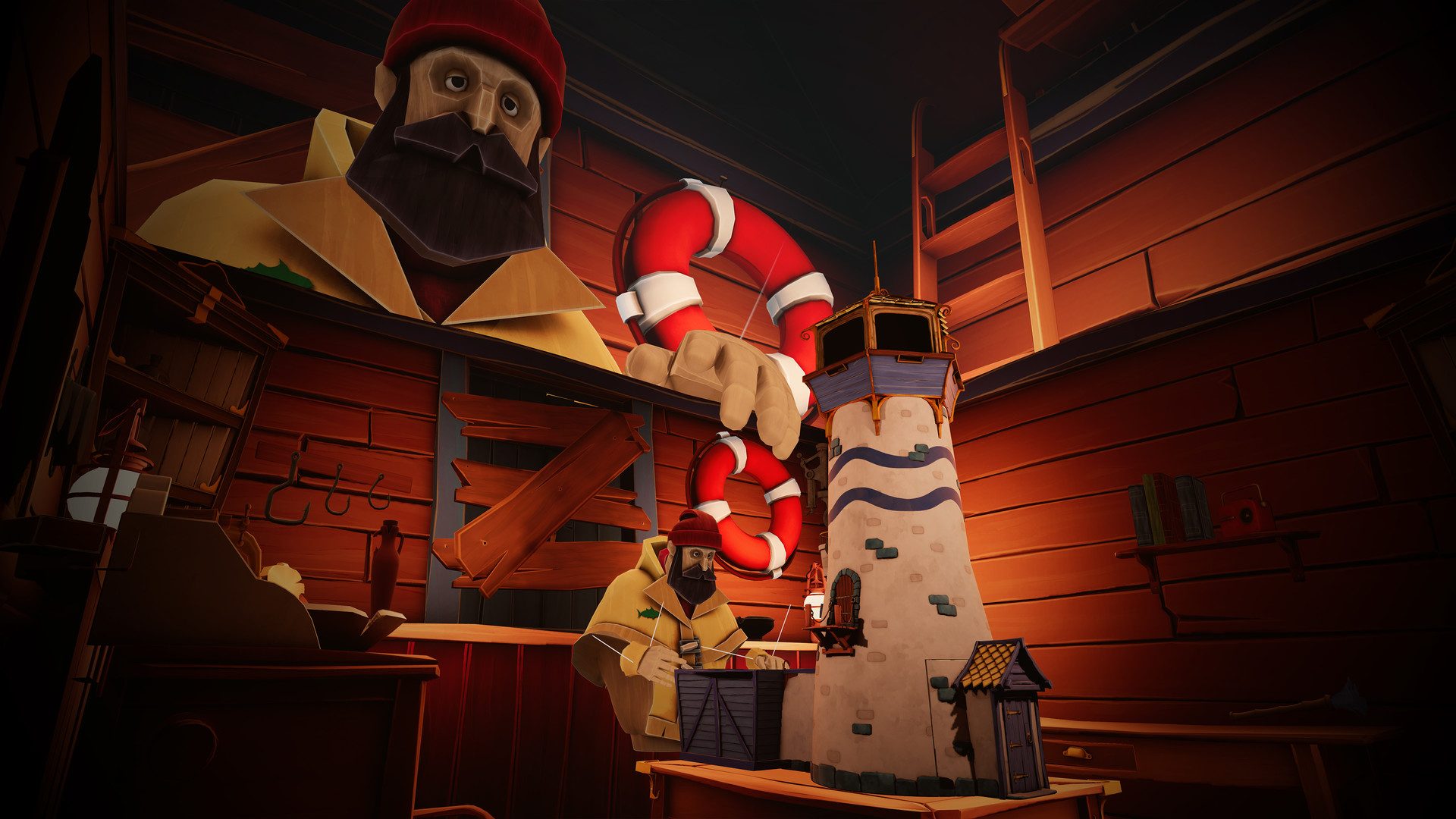A Fisherman’s Tale puts you in the boots of a curios puppet-man named Bob who lives in a strange, recursive world centered around a dollhouse-sized lighthouse. Looking above, you see infinitely Big Bob. Looking below, infinitely Small Bob. It sounds like a trip, and it is: a quick trip into a super French storybook that’s begging to be fleshed out into something more substantial.
A Fisherman’s Tale Details:
Publisher: Vertigo Games
Developer: Innerspace VR, ARTE France
Available On: Oculus Rift, HTC Vive, Windows VR, PlayStation VR
Reviewed On: Oculus Rift, HTC Vive
Release Date: January 22nd, 2019
Gameplay
A Fisherman’s Tale is a single-player adventure game built around a series of escape rooms that feature light puzzle solving and much more prominent story-telling elements.
It’s main claim to fame is the innovative dollhouse mechanic, which lets you not only see a smaller in-sync version of yourself in a perfect miniature representation of your lighthouse, but also a giant doppelganger towering above. The idea is to interact with the smaller/larger recursive copy of yourself by handing up or down items with an eye for tactically resizing them to fit the situation.
To be honest, it felt like the game only scratched the surface of what’s actually possible here. I could have easily strapped in for a more serious interaction with what you might call the ‘single player co-op’ mechanic, which lets you do things like pick up a giant anchor blocking a door, but what in the context of the game is also a pint-sized dollhouse item that you can easily lift away and use for something else.
The story line skews pretty young, and feels more like someone reading a storybook aloud to you. While it might be perfect for kids ages seven and up, it personally seemed a little too simplistic to be truly enjoyable. The game’s well-realized environment and mind-bending infinity were the true stars of the show here, but I would have welcomed something a little more substantial, and a little less “we must give Mr. Fishy something to drink!”
At one point, the story does turn a tiny, oh so tiny bit dark when we learn that the lighthouse keeper’s father was a negative bastard who hated his son for not being a fisherman, but a few stern words from Dad was it. There was real potential there to create some character defining moments, flashbacks, anything to get us caring about the relationship, but like the game itself, the moment slipped away upon reaching the next room.
Most of the puzzles were interesting in construction, although were fairly simple even without the narrator’s hints, which can be toggled on and off mid-game. There was one puzzle where the recursive puppet world doesn’t work in the same way as previously introduced, forcing you to stretch both your arms and your imagination a little bit to solve.
I desperately wanted more of these intriguing moments but sadly was only given one. As it is, there are only six or seven fundamental puzzles to solve, a true shame considering the high production value of nearly every aspect of the game up to that point. That said, there’s no filler here, no convoluted tasks for the sake of it, which is nice. But that doesn’t play a large enough counter balance to the overall lack of puzzles, and difficulty range that spanned ‘very easy’ to ‘slightly less easy’.
My personal gameplay time was about one hour, and that was playing without hints at a leisurely pace. Even if I had played all the way through with hints, I’m not certain the time would have changed by much, as I knew basically what to do immediately anyway.
Immersion
With the narrator voiced by the never-not-smoking French comedian Augustin Jacob, the game feels more akin to the sort of kitschy and experimental short film that comes on before a Pixar movie—charming for just long enough, but really only an appetizer to what should be a larger meal.
You’ll hear plenty of “zut alors!” and “sacré bleu!” to underline the fact that A Fisherman’s Tale is a French production made by people who care that you know this; it was after all co-produced by Franco-German cultural TV network ARTE France and Paris-based studio Innerspace VR.
Anyway, the game’s voice acting is nothing short of awesome. The narrator’s raspy, smoky voice adds a degree of seasoned authenticity to an admittedly banal, but inoffensive storyline. Jacob’s performance elevates at every turn, pushing it in a higher direction artistically despite the low complexity both story and puzzle-wise.
Visually, A Fisherman’s Tale plays host to a number of well realized set pieces that change shape and function throughout the story, sometimes offering a different way to interact with the world thanks to the re-sizing mechanic. The visual style feels extremely cohesive, with everything in A Fisherman’s Tale tending towards the devastatingly cozy end of the spectrum. It’s easy to fall in love with the look and feel of the environment, but again, I only wish I could have had more play time to soak in what’s clearly the result of a collectively competent hand in VR game design.
Comfort
A Fisherman’s Tale features basically the full gamut of comfort styles, including standing or sitting modes, and room-scale or standing snap-turn for users with front-facing sensors.
Locomotion is based on teleportation, although the game plays out in such a small physical playspace that much of it can be traversed in room-scale.
However you slice it, A Fisherman’s Tale is extremely comfortable experience, making it ideal for VR newcomers or users that are sensitive to artificial locomotion.
– – — – –
WE SCORE ON A LINEAR SCALE – Learn More
Gameplay: 5.5 | Immersion: 7.5 | Comfort: 9


